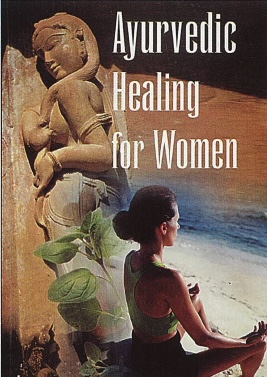HEALTHY LADY
BETTER FEMININE HEALTH WITH INDIA’S TRADITIONAL MEDICINE
By Tara Katir, Kapaa, Hawaii
So you think monthly discomfort, emotional mood swings, bone density loss, hot flashes and other afflictions are normal and should be expected? Not according to Ayurvedic Healing for Women by Atreya [241 pages, Samuel Weiser, Inc., US$14.95]. Concentrating solely upon women’s health care, Atreya presents readers with an array of traditional ayurvedic knowledge. Beginning with the three doshas, or bodily constitutions, Atreya establishes the framework for understanding ayurveda. Treatments for specific metabolic imbalances are outlined in part two. Atreya cautions readers to “seek professional help first to determine the problem, then study your options. A book can help you explore options once you know what you are up against–that is the purpose of this section–not to diagnose, but to offer my experience in treating certain types of problems using the ayurvedic system.”
Herbal treatments for depression, menstrual difficulties and post menopause, to the more serious maladies of cysts, fibroids and endrometriosis, are outlined along with informative case histories. The chapter entitled “Nutrition as a Healing Power” admonishes everyone to become vegetarian, “The medical evidence is overwhelming: a long-term diet based on animal foods is detrimental.” Going further, he advises we eat organic food as close to its natural state as possible for increased nutritional content. The best is from your home garden. Eat foods that balance, not imbalance, our constitution and leave ample time for digestion. He points out that common Western “women’s problems” such as cysts and fibroids, are regarded by ayurveda as the result of harmful chemicals in our diet. Treatment, he says, is possible by change of diet and lifestyle instead of surgery. Also included are useful appendices on pharmaceutical medications, pregnancy and childbirth, and an extensive herbal glossary that provide easy recognition of herbs in English, Latin and Sanskrit. For the serious seeker, a list of ayurvedic schools, treatment centers and herbal suppliers in the United States round out this self-help guide.
HOW TO BE A VEGAN
Consuming with restraint could be the vegan’s code of ethics. For those unfamiliar with veganism, an explanation may be necessary. Vegans, besides being strict vegetarian, eschew the use of animal products and by-products, including eggs, dairy products, honey, leather, fur, wool, soaps or toothpastes that may contain lard. If you subscribe to the ethics of veganism, or want to, Simply Vegan by Debra Wasserman [224 pages, The Vegetarian Resource Group, US$12.95] is an outstanding resource. Beginning with foods, Wasserman’s tasty recipes nourish the body and assuage the conscience. The second half of the book is devoted to nutrition, replete with easy-to-understand charts and supportive reference books at the end of each section. If you like to shop by mail, there is an extensive listing of cruelty-free commercial products. Included are foods, organic garden seeds, cosmetics, household and personal care products. All in all, this is a fantastic guidebook for gentle living
THE GUIDE TO YOGA AT WORK
As your sedentary desk job a pain in the neck, not to mention the cause of sore eyes and a stiff lower back? These are but a few of the occupational hazards in our urban office lifestyle. Physical and mental tensions and their corresponding aches and pains are constant companions for many. Bringing the promise of soothing relief is a “survival handbook for the desk bound,” Office Yoga by Julie Friedeberger [155 pages, Motilal Banarsidass Publishers, Rs.75]. A critical look at the basics–chairs, desks, lighting and beneficial sitting postures–introduces Friedeberger’s recommendations for relief. Then follow seven chapters detailing exercises to do while sitting or standing, each illustrated for ease in understanding. Are you alarmed at the thought of exercising in your office? Friedeberger encourages us, saying that many of the movements can be done quite unobtrusively, and after feeling their benefits you may grow bolder. From quiet eye, shoulder, wrist, finger, ankle and knee exercises to more dynamic standing forward bends and side stretches, Friedeberger leads you through a yoga workout designed to alleviate tension and promote well-being. An entire chapter is dedicated to correct breathing. Office pranayama helps “establish one-pointedness, or concentration, necessary to fulfill our responsibilities and our potential.” If you are aching to alleviate that testy tension, check out Office Yoga. Relief may be just a stretch away.


